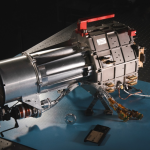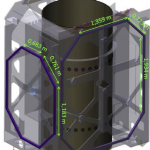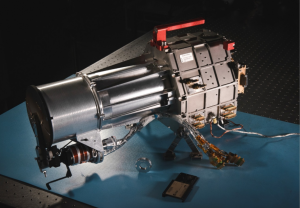
The Radio and Plasma Wave Investigation (RPWI) : Onboard JUICE:
The JUpiter ICy moon Explorer (JUICE) is an ESA-led mission with strong involvement from Japan. The “ONBOARD JUICE” series looks at the instruments on JUICE for which Japan has contributed hardware or expertise. An introduction to the mission and instrument overview can be found [here].
Author: Kasaba Yasumasa (Tohoku University), lead researcher for RPWI-Japan
Quick fact sheet: RPWI
The Radio & Plasma Wave Investigation (RPWI) aboard JUICE provides a unique opportunity to make the first measurement of the full components of electromagnetic wave vectors (direction and intensity in all three dimensions of the electric and magnetic fields) and the cold plasma environment around Jupiter and the icy moons. These measurements can probe the structure and motion of Jupiter’s strong magnetosphere and the effects on the planet’s icy moons. RPWI will also characterise the ionospheres (the top layer of the moons’ tenuous atmosphere), icy crusts and subsurface oceans of the icy moons during the flybys and on the orbit around Ganymede.

RPWI was developed by a joint European and Japanese team, and will bring to the Jupiter system the first capability to observe low-temperature plasma (electrons & ions), electric field and low-frequency electromagnetic waves with full vector components (intensity and direction), energy exchanges between waves and ions, and radio waves with their direction and polarisation. The European team members brought expertise developed for the instruments onboard the Cassini spacecraft that visited Saturn. The expertise of the Japanese members is from instruments onboard Kaguya (Lunar orbiter), Arase (radiation-belt observations), and BepiColombo (Euro-Japan joint mission to Mercury).
RPWI has huge sensors deployed outside the spacecraft for sounding the surrounding plasma by detecting radio waves, and radio remote sensing (see diagram of JUICE above). These sensors are of three different types:
- Langmuir probes (LP-PWI): By the combination of four 10 cm spherical probes on four 3 m booms, these measure cold plasmas and the intensity of the electric field in all three directions (3-axis electric field vector) up to frequencies of 1.6 MHz.
- A search coil magnetometer (SCM): This measures the intensity of the magnetic field in three directions (3-axis magnetic field vector) up to frequencies of 20 kHz.
- A tri-dipole 2.5 m tip-to-tip length antenna system (RWI): This measures the intensity of the radio waves coming from three directions (3-axis radio wave vector) between frequencies of 0.08 – 45 MHz. RWI is on the long boom (10.6 m length) with SCM and J-MAG (magnetometer).

These three sensors will provide the first detection capabilities for the following in the Jupiter system:
- Low-temperature electrons and ions and the intensity and direction of the electric field.
(→ Langmuir Probe system: LP-PWI + Langmuir Probe receiver.) - Low-frequency electromagnetic waves with full vector components (three dimensional intensity and direction with the monitoring function (realised by the “wave particle interaction analyzer” software) for energy exchange between electromagnetic waves – ions(++) .
(→ Low Frequency system: LP-PWI + SCM + Low Frequency receiver.)
(++) The RPWI-Japan team members contributed to the concept design and software for this detector, together with the with Sweden and Czech teams. - Radio waves with their direction, polarisation, and use in passive radar.
(→ High Frequency system: RWI + High Frequency receiver.)
The JUICE RPWI Japan team (led by Tohoku University) designed the sensors that provide the High Frequency system for radio observation capabilities (written as bold), in collaboration with Sweden, France, Poland, and Austria. We were able to confirm that our system has sufficient sensitivity to approach even the levels of the galactic radio background, which assures us that we will be able to see all strong and weak radio signals in the Jupiter system!

The frequency range of our High Frequency system covers the radio emission from the Jovian powerful aurora (the largest aurora in the Solar System), lightning in Jupiter’s atmosphere, plasma ejected from the volcanos on Io, and the ionospheres surrounding the icy moons (shown in the above diagram). The Earth also has an aurora and lightening, but Jupiter’s activities are at a different order of magnitude in strength. The capability to measure the direction and polarisation of radio waves can identify their source locations and characteristics for the first time.
Jupiter’s radiation also illuminates the icy moons like a strong “search light”. We will use the radio waves in this Jovian search light for radio sounding of the icy moons. As the moons eclipse part of the strong Jovian radio emissions, we can examine the change in radio emission as the radio waves pass through the icy moons’ ionospheres below the spacecraft orbit. This has the capability to measure not only the usual ionosphere of the moons, but also to discover the episodic plumes that can be ejected by crustal and subsurface activities. On the other hand, the Jovian radiation reflected from icy moons can be used for the challenging remote sensing of surface and subsurfaces. We will try to do this Passive Sub-Surface Radar (PSSR) technique, which detects radio waves reflecting from the surface and different depths beneath the moons’ icy crust. The differences in the intensity and the phase of the radio waves reflected from the icy moon’s interior, versus from the surface, gives information about the structure that must lies below the icy crust.
The JUICE RPWI Japan team have a chance to perform these first and unique observations of the electromagnetic fields and plasma environment around Jupiter and icy moons. With the RPWI team and other payloads aboard the JUICE spacecraft, we will enjoy the various discoveries of Jupiter and icy moons.
(Figures from 日本惑星科学会誌, 25, 3, 96-107, 2016.)
Further information:
The JUICE Mission: Japan joins ESA to head to the icy moons
RPWI Fact Sheet
JUICE Japan website

 Previous Post
Previous Post Next Post
Next Post






